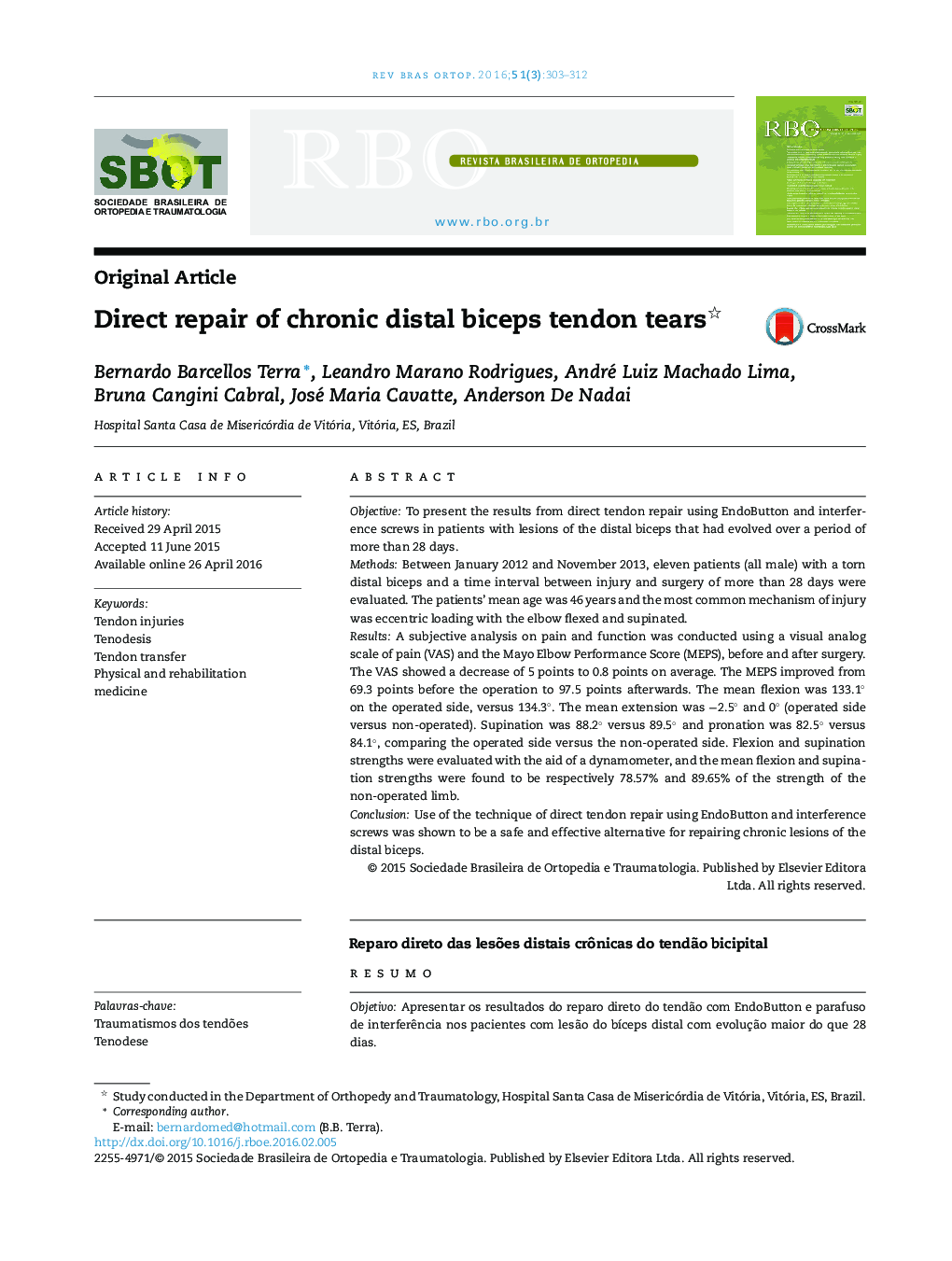| کد مقاله | کد نشریه | سال انتشار | مقاله انگلیسی | نسخه تمام متن |
|---|---|---|---|---|
| 2708276 | 1144896 | 2016 | 10 صفحه PDF | دانلود رایگان |
ObjectiveTo present the results from direct tendon repair using EndoButton and interference screws in patients with lesions of the distal biceps that had evolved over a period of more than 28 days.MethodsBetween January 2012 and November 2013, eleven patients (all male) with a torn distal biceps and a time interval between injury and surgery of more than 28 days were evaluated. The patients’ mean age was 46 years and the most common mechanism of injury was eccentric loading with the elbow flexed and supinated.ResultsA subjective analysis on pain and function was conducted using a visual analog scale of pain (VAS) and the Mayo Elbow Performance Score (MEPS), before and after surgery. The VAS showed a decrease of 5 points to 0.8 points on average. The MEPS improved from 69.3 points before the operation to 97.5 points afterwards. The mean flexion was 133.1° on the operated side, versus 134.3°. The mean extension was −2.5° and 0° (operated side versus non-operated). Supination was 88.2° versus 89.5° and pronation was 82.5° versus 84.1°, comparing the operated side versus the non-operated side. Flexion and supination strengths were evaluated with the aid of a dynamometer, and the mean flexion and supination strengths were found to be respectively 78.57% and 89.65% of the strength of the non-operated limb.ConclusionUse of the technique of direct tendon repair using EndoButton and interference screws was shown to be a safe and effective alternative for repairing chronic lesions of the distal biceps.
ResumoObjetivoApresentar os resultados do reparo direto do tendão com EndoButton e parafuso de interferência nos pacientes com lesão do bíceps distal com evolução maior do que 28 dias.MétodosEntre janeiro de 2012 e novembro de 2013, 11 pacientes (todos do sexo masculino) com ruptura do bíceps distal com intervalo da lesão e cirurgia maior do que 28 dias. A idade média foi de 46 anos e o mecanismo de trauma mais comum foi uma carga excêntrica com o cotovelo em flexão e supinação.ResultadosFoi feita uma análise subjetiva da dor e função com a Escala Visual Analógica de Dor (EVA) e o Mayo Elbow Performance Score (MEPS) pré e pós-operatório. Houve uma diminuição da EVA de 5 pontos para 0,8 ponto em média. O MEPS melhorou de 69,3 pontos no pré para 97,5 pontos no pós-operatório. A média de flexão foi de 133,1° do lado operado contra 134,3°. A média de extensão foi de −2,5̊ e 0° (lado operado × não operado). Supinação foi de 88,2° × 89,5° e pronação 82,5° × 84,1° quando comparado o lado operado versus o lado não operado. A força de flexão e supinação foi avaliada com o auxílio de um dinamômetro e verificamos que a força média de flexão e supinação correspondia, respectivamente, a 78,57% e 89,65% a força do membro não operado.ConclusãoA técnica do reparo direto do tendão com o uso de EndoButton e parafuso de interferência mostra-se como uma opção segura e eficaz para o reparo direto das lesões crônicas do bíceps distal.
Journal: Revista Brasileira de Ortopedia (English Edition) - Volume 51, Issue 3, May–June 2016, Pages 303–312
